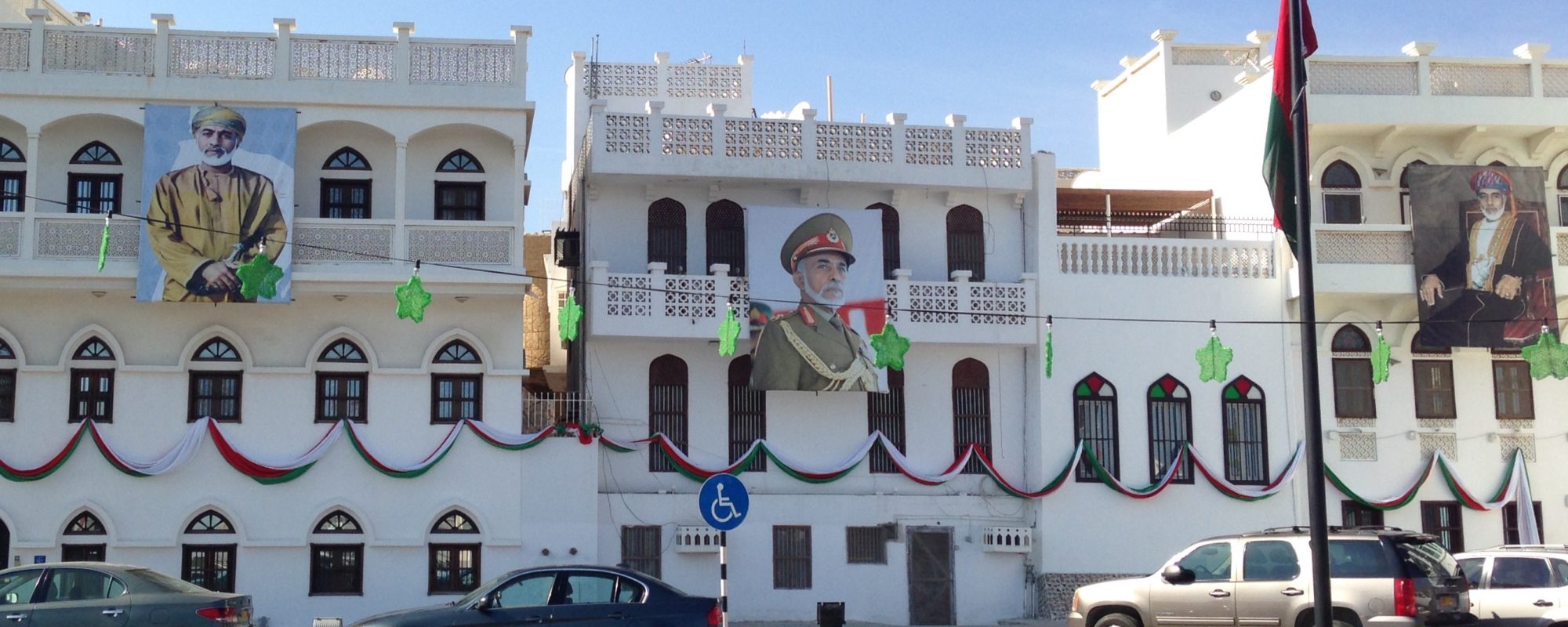Oman commemorated its 45th National Day on November 18th, which was also His Majesty Sultan Qaboos’s 75th birthday. Festivities weren’t confined to just one day. Preparations were visible in early September, and some of the most anticipated celebrations occurred in December, long after his birthday. In fact, sometimes it feels like every day is National Day in Oman, where patriotism and public devotion to His Majesty Sultan Qaboos1 are an integral part of the national psyche.
For example, every morning at 7:30 a.m., a familiar song plays outside my bedroom window, and I often subconsciously hum along the opening words. Ya rabbina ahfadlina jalalat as-sultan, or “Oh God, preserve for us His Majesty the Sultan.” The national anthem of Oman, or as-Salaam as-Sultani as it’s called, blares over the loudspeakers from the school across the street each day, signaling that it’s time to get going. Absharee! Qaboos jaa fil tubakaru al-samaa, wa saadi wa altuqhi bil-dua’ — “Rejoice! Qaboos has come with the blessing of heaven, be happy and pray for him.”
Then, at 8:00, when I’m usually listening to the news, another orchestral march interrupts the regular broadcast, followed by a short audio excerpt from one of His Majesty Sultan Qaboos’s many speeches from the past 45 years. After the clip, a brief trumpet coda, followed by the rousing chorus of Sawtun lil-Nahdati Nada, or “The Voice of the Renaissance Calls.” The same speech excerpt and song is then played again at 5:00 p.m., and the two have become important punctuation marks in my day, along with the national anthem and intermittent calls-to-prayer from the mosque beside my apartment.
At first, it was unintentional — I would have the radio on in the background and turn up the volume to hear the catchy Sousa-like fanfare of Sawtun. But as I fell into a routine here in Muscat, I’ve found myself dutifully turning on the radio to hear just what the Voice of the Renaissance has to say each day. Leading up to National Day, the speech excerpts became longer, sometimes as long as a half hour. Then, on November 18th, His Majesty’s most recent speech at the Council of Oman, an institution similar to a parliament, was played every hour on the hour, in between patriotic marches and news reports from celebrations across the Sultanate.
It is impossible to overstate how important His Majesty Sultan Qaboos is to Omani national identity. An-nahda al-mubaraka, or the Blessed Renaissance as Omanis call it, began in 1970 when His Majesty ascended to the throne, and Omanis of all stripes have been continuously singing his praises — literally and figuratively — ever since. A Times of Oman article this month entitled “His Majesty lauded for his role as global peacemaker” captures the gist of their gratefulness: “His Majesty transformed a very backward country into one of the most developed nations and delivered on every promise to his people, forfeiting personal comfort and freedom.”
The entirety of this month’s Business Today (Oman) is devoted to public letters from forty-five CEO’s, chairmen, and other “prominent business personalities” in honor of the 45th National Day. “His Majesty Sultan Qaboos bin Said has served his country like no other,” one began. “…and to have seen the evolvement of Oman over the past 45 years, one can only admire and respect him. Having grown up in the sixties in Oman, I can proudly say that His Majesty the Sultan has kept his promise of looking after us all and showing us a better, brighter future.” Another reads, “When we see what Oman has become today and what has been achieved in the last 45 years, a glorious image of His Majesty Sultan Qaboos bin Said rises and brightens our thoughts. His Majesty the Sultan has always been an inspiration to Oman and Omanis. We look at the transformation of the country from what it was in 1970 to what it is today and we are overwhelmed with pride and gratitude.” Each of the articles touches on the common refrain: darkness before His Majesty, and light during the Renaissance. Even expat business leaders joined in too, praising His Majesty’s leadership as “visionary,” “wise,” “forward-thinking,” and “futuristic.”
My favorite was published in Muscat Daily, in a piece entitled “His Majesty Baba2 Qaboos is my hero.” In it, a 5-year-old Omani boy expressed precocious delight over His Majesty’s good health medical treatment abroad: “When we got the news of His Majesty the Sultan’s return from Germany after treatment, we immediately went home, prayed, and celebrated. After a few days in the name of Allah we slaughtered 45 goats, as Allah had accepted our prayers. He [the Sultan] is fine now and celebrating 45th National Day with us in Oman.” Omanis are genuinely enamored by His Majesty, and their patriotism is dedicated as much to him, the individual, as it is to Oman, its flag, and its principles. L’etat c’est lui.
National Day wishes for His Majesty aren’t just limited to Omanis, either. Burj al-Arab, the tower commonly known as “the sail” in neighboring Dubai, was alight with a picture of His Majesty on November 18th. Dozens of Emiratis decorated their cars with pictures of Sultan Qaboos and Sheikh Zayed, the first ruler of the U.A.E., and drove to Muscat in a show of brotherly support. Even Secretary of State John Kerry popped into Oman’s National Day celebrations at the Willard Hotel in D.C., saying that His Majesty is “such a friend, and is so remarkable in his leadership… He has a special sense of tolerance, a special sense of peace, and a commitment for Oman to be a leader… So I wish [him] a very very happy National Day. We’ve had a remarkable relationship for all of those forty-five years, we’re very grateful for every day of it, and may there be many, many, many more. In sha Allah.” Her Excellency Hunaina Al Mughairy, Oman’s ambassador to the U.S. and Chair of my old place of work, the Sultan Qaboos Cultural Center, looked on smiling widely and nodding.
Adoration for His Majesty pervades every aspect of life in Oman. Portraits hang in every single business in the Sultanate, year round — whether it is a car dealership, shopping mall, local tea shop, or American school. During National Day season, portraits are hung next to existing portraits, in windows, outdoor walls, and on bridges, roads, and street signs. Near the end of October this year, the souq started to fill with loads of freshly unboxed gear specific to this year’s celebrations. Bunting, hand-held flags, scarves, hats and shirts all with His Majesty’s face, the number 45, and the flag and royal emblem of Oman replaced the usual cheap Arabesque tchotchkes for sale in the market. Supermarkets and chain stores decorated their windows with red, green, and white balloons and draped enormous Omani flags or pictures of His Majesty from their rooftops.
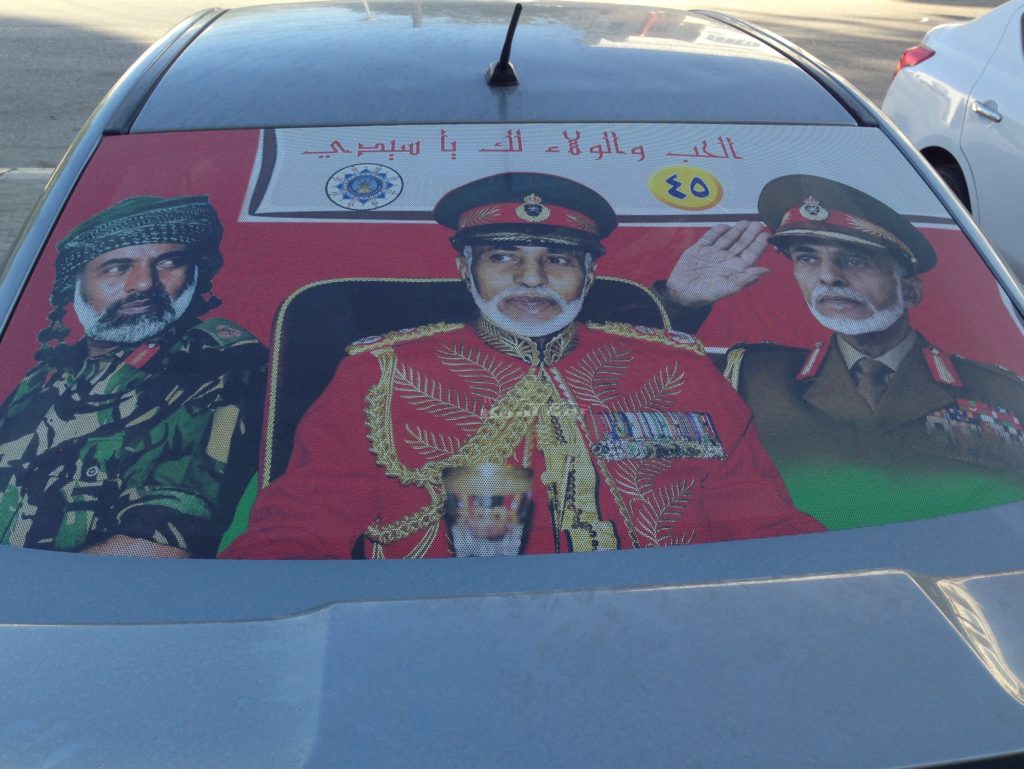
The most eye-catching displays of nationalistic fervor, however, were car wraps and decals. Each November, the Royal Oman Police loosens its (famously strict) restrictions on automobile exteriors and releases guidelines for the acceptable decoration of vehicles. Many Omanis push these guidelines to the limit, treating their cars as blank canvasses, covering every inch in pictures of His Majesty and hoping the police will turn a blind eye to the extra-patriotic rule benders. There’s almost a competitive quality as to who can cover their car with the most patriotic images and slogans. On some, a collage of images of his His Majesty from throughout the Renaissance are placed next to one another — in fatigues in the 70s, in timeless traditional royal dress, in mess-hall military in the 80s, or in a Nehru jacket and Cossack cap this year. Others used washable paints to draw hearts, curlicues, the number 45, and His Majesty’s name from hood to tail.
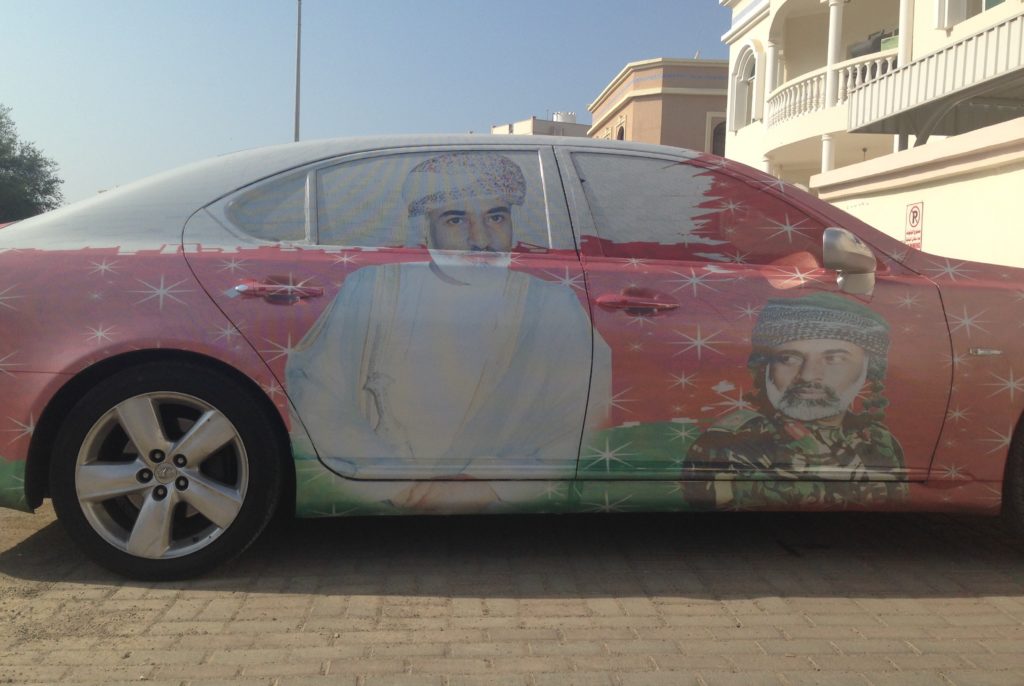
In an earnest display of national pride, everyone then showcases their cars on November 18th by creating an intentional traffic jam on Shatti Street, a popular beach-side road (its namesake), waving flags out the window and honking. Hoping to show Emily some of this impromptu nationalism, we set out for Shatti Street on November 18th at dusk, but were completely stopped in traffic over a mile away from it — effectively waiting in traffic on our way to more traffic. At first, the mood was euphoric. Bedouin from the interior, the cowboys of Oman, had come out in droves in their iconic boxy Toyota Land Cruiser pick-ups. They stood on the roofs of their cars as we all inched forward, singing, honking jubilantly, and showing off pricey decals of His Majesty’s face. Five young Bedu with sloppily tied turbans stuck their heads out of the windows of a single car and yelled rural slang for “what’s up,” and signaled for me to “come for coffee” when I responded in a Bedouin accent. I thought I heard bursts of celebratory gunfire in the distance — something that the police frown upon but have difficulty curtailing.
Soon, we were in absolute gridlock, stuck in park for more than thirty minutes. We no longer heard festive music, and people had gotten out of their cars and were walking around to see what was going on. The crowd was men-only, and many of them had covered their faces with their mussars, or turbans. A man in a clown mask and wig was directing a group of Bedouin in their trucks over the center divider of the road to the area in front of us, where they revved their engines to the absolute maximum, intentionally causing them to backfire in spurts. This was the noise I’d heard earlier, not gunshots. Their mufflers flashed like gun barrels with each ear-splitting pop, and together, they made the otherwise peaceful beachside neighborhood sound like a battlefield. As we slowly rolled forward, men in dishdasha and hidden faces lined the road for hundreds of meters. It wasn’t until the cadre of Bedouin trucks zoomed off and left just two cars in front of us that I realized they had been blocking the road for drag racing, entertaining the spectators with engine tricks. Emily and I couldn’t help but be reminded of the unhinged rural American pride in Eastern Kentucky, where we’ve spent most of our Fourths of July together, watching fireworks from a Wal-Mart parking lot, while Appalachians burn rubber and fix sparklers to their pick-ups.
Despite this, the majority of National Day celebrations are much tamer in nature. Throughout the week of November 18th, schoolchildren with painted faces march in the streets behind their teachers, who hold framed portraits of His Majesty high above their heads. Our local grocery store had games and prizes for children, who danced under balloon arches in their finest clothing, led by the usually quiet Indian clerks. An Omani friend sent me an unprompted text of his toddler-aged son kissing an enormous portrait of Sultan Qaboos. Omani office workers brought plates of traditional sweets to share with their colleagues. In one of Muscat’s many malls, a huge wall near the entrance read, “Express your infinite love for the nation and our beloved Sultan. My Sultan… My Oman,” and people wrote pleasant messages in an orderly fashion. “I love you Baba Qaboos,” “My hero my Sultan,” and “Allah protect His Majesty” were among the graffiti.
Official celebrations were held in each of Oman’s governorates, spread out over the course of a week. The performances involved dances, marching, and salutatory music for His Majesty, and incorporated local traditions from each of governorate. His Majesty presides over just one such celebration each year, and this year it was a large military parade in Manah, a remote village of historical importance to Omanis. Thousands of soldiers sung praise hymns to their leader as they marched and demonstrated the might of Oman’s Royal Armed Forces. Footage from the proceedings showed His Majesty looking on approvingly in his pristine military uniform as canon fire blasted and bagpipers marched.
I had the opportunity to attend the official celebration in Muscat, which was presided over by Deputy Prime Minister Sayyid Fahad bin Mahmood (His Majesty is the Prime Minister). The performance had the air of an Olympic opening ceremony, replete with a story line, elaborate costumes and set pieces, and fireworks. Six-thousand students took part in the ceremony, and the acts had titles like “Oman’s Renaissance and the Joy of Meeting,” and “Pride and Esteem for the Leader of the Renaissance.”
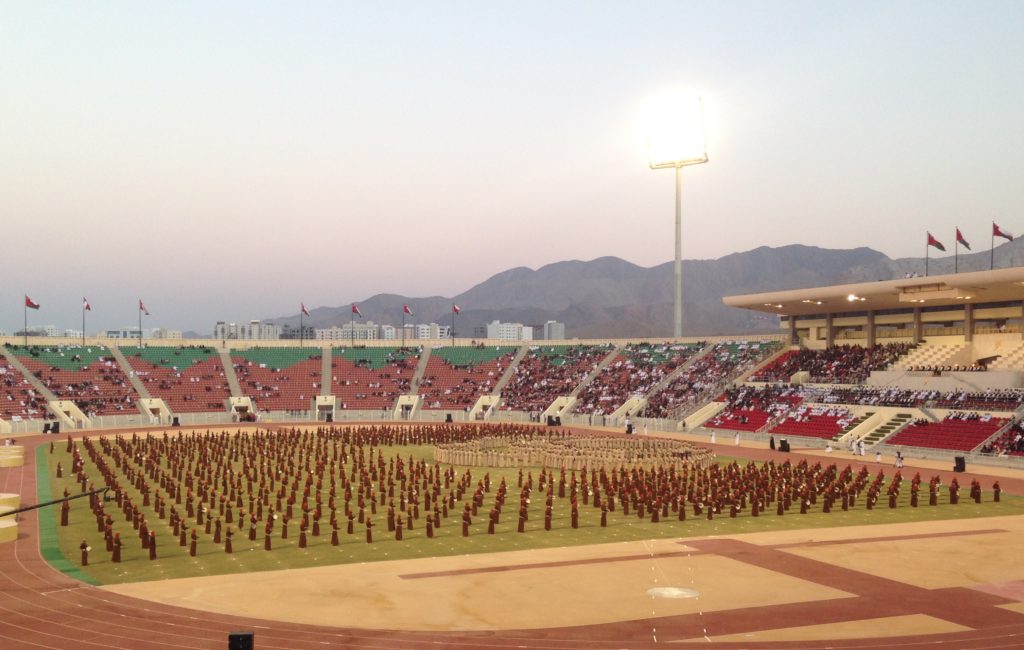
Over the course of the evening, the students progressed from young to old, each in elaborate variations of traditional Omani dress. Girls had gold chains atop their heads, and boys wore flowing black bishts with gold tassels, ceremonial robes reserved only for the most formal occasions.
The second-to-last song was a piece of Bedouin praise poetry for Oman and its Sultan, and had an element of crowd-participation; any time His Majesty’s name was mentioned, the crowd cheered wildly, women ululated, and hands raised to wave their flags. It ended with the leader of the chant singing “and the Muslims say…” to which the entire stadium replied with a resounding Allahu akbar. For the grand finale, all performers came out together, children beside adults, and each holding a photograph of His Majesty above their head while fireworks boomed outside the field.
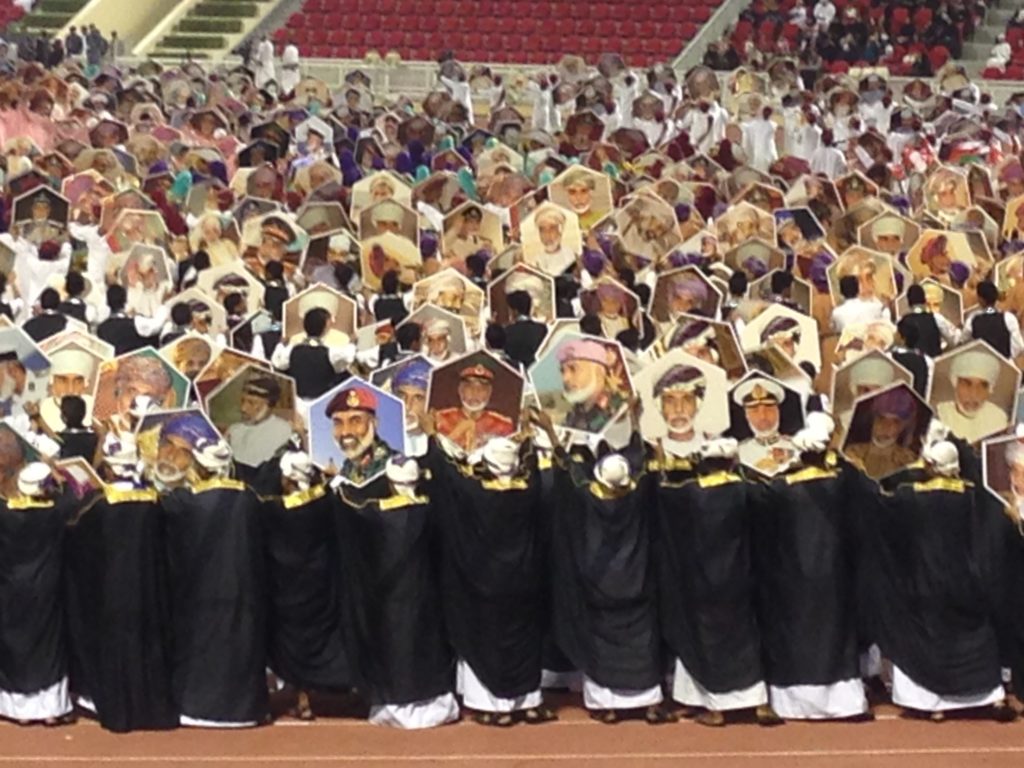
We couldn’t see them from inside the stadium, and tried to leave in order to catch sight of them, but were gated in by the police. Only when His Highness Sayyid Fahad stood were the gates opened, and we caught a fleeting glimpse of the last glittery crackles before only smoke remained.
Cultural programs and festivals continued through the rest of the month in parks and museums across Oman, and the festivities didn’t truly come to an end until the beginning of December. Each year, His Majesty announces days off to celebrate National Day, but they’re never actually on November 18th, lest too many people go on vacation on His Majesty’s birthday and skip the patriotic revelry. This year, the holidays were announced as December 2nd and 3rd. An Arabic hash tag made the rounds leading up to the break, translating to #SpendtheNationalDayHolidayinOman. While many chose to spend it elsewhere, and while the official festivities have concluded, the Voice of the Renaissance still speaks on the radio each morning and evening, and Omanis continue to sing their Sultan’s praises each day.
[1] In this article, I use His Majesty, or His Majesty the Sultan in order to conform with local standards of respect. This is an abbreviation from what is normally used in the media here: hadhrat sahib al-jalala al-Sultan Qaboos bin Said al-muazzam hafizu Allah wa raa, or roughly, The Eminent His Majesty Sultan Qaboos, son of Said, May God protect and preserve him.
[2] Baba means “Dad.” His Majesty is also called walidi, and abi in Omani songs, other paternalistic names.

